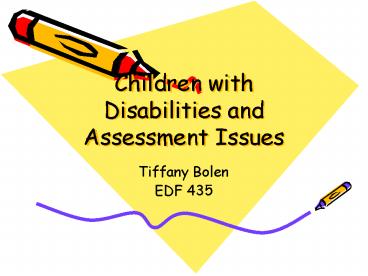Children with Disabilities and Assessment Issues - PowerPoint PPT Presentation
1 / 15
Title:
Children with Disabilities and Assessment Issues
Description:
... Law 101-476, now commonly know as the Individuals with Disabilities Act (IDEA). The following requirements are mandated by the IDEA ... – PowerPoint PPT presentation
Number of Views:73
Avg rating:3.0/5.0
Title: Children with Disabilities and Assessment Issues
1
Children with Disabilities and Assessment Issues
- Tiffany Bolen
- EDF 435
2
The Defining Aspects of Special Education
- Special education involves providing a free and
appropriate education for every child with
disabilities between the ages of 3 and 21,
regardless of how serious the disability may be. - This is know as the Public Law 101-476, now
commonly know as the Individuals with
Disabilities Act (IDEA).
3
The following requirements are mandated by the
IDEA
- All children with disabilities, ages 3 through
21, have the right to free and appropriate
education. - All children with disabilities have the right to
the least restrictive environment. This means
that children with disabilities should be placed
in the most normal setting as possible. They
should be mainstreamed or placed in the regular
classroom whenever possible.
4
- Each child with disabilities should have an
individualized education plan (IEP) written by a
multidisciplinary team composed of the classroom
teacher, the special education teacher, the
school psychologist, and the childs parents.
5
- All assessments used to measure, diagnose, or
place children with disabilities must be free
from racial and cultural bias. - Children with disabilities will be identified
through psycho-educational evaluation composed of
a series of appropriate assessments.
6
- The final decision for placement in a special
education program will not be made until after a
thorough evaluation. This decision for placement
will be made by a multidisciplinary team composed
of teachers, administrators, school
psychologists, and the parents.
7
Special Education Categories
- The different categories of children with
disabilities have changes since the inception of
Public Law 94-142. In particular, the growth of
the category of children with learning
disabilities if frequently noted.
8
- Learning disabilities now account for over half
of all special education placements. - Speech impairments account for nearly 20 percent
of all placements. - Mental retarded account for 11 percent of all
placements. - Emotionally disturbed account for 8 percent of
all placements.
9
- These four categories account for nearly 90
percent of the 5.5 million children who receive
special education in the U.S. schools - (U.S. Department of Education, 2000)
10
Assessment and Diagnosis of Children with
Disabilities
- It is important for regular classroom teachers to
understand the different assessment criteria used
to diagnose students. - It is even more important for teachers to be able
to detect any signs of disabilities, particularly
in the areas of learning disabilities, emotional
disorders, and ADHD. - Regular classroom teachers often initiate the
process for detecting, assessing, and referring
these categories of children with disabilities.
11
Standard Deviation and Special Education
- Many state regulations for determining who
receives special education are based solely on
standard deviation scores. - Generally, IQ scores that are two standard
deviations below the mean or lower are a
diagnostic sign of mental retardation.
12
- On the Wechsler test battery, this would be an IQ
score of 70 or lower. - Based on the normal curve, the percentage of the
population that will score 70 or less is
approximately 2.5 percent. - On the Standford-Binet, the cut off score is 68
or two standard deviations below the mean.
13
- In determining if a child has a learning
disability, a frequently used diagnostic sign is
a one standard deviation or greater difference
between the Verbal and Performance parts of the
WISC-III. - For example, if a childs Verbal score is 84 and
his Performance score is 107, it could be
indicative of a language-related learning
disability such as dyslexia.
14
The End!
- Any Questions?
15
(No Transcript)

